
|   |

|   |
 e-mail: sunilkothari1933@gmail.com NCPA's signature Mudra Dance Festival Photos courtesy: Narendra Dangiya and NCPA May 3, 2018 Come April and NCPA mounts its signature Mudra Dance Festival inviting leading dancers to explore various aspects of classical dance forms. This year the festival embraced the interconnectedness between mind, body and soul through the spirit of classical dance. The dancers interpreted in a variety of ways, seeking to explore how the unique cultural contexts of Indian classical dance were formed, and how they come together for a purpose. The lineup of performers raised high expectations. And it must be said to the credit of the dancers that they put their best feet forward offering to rasikas an elevating experience. Bharatanatyam: Sahahridaya 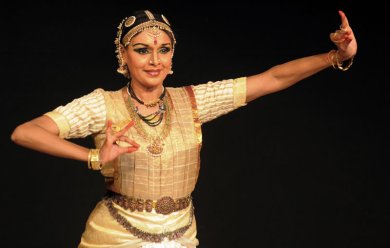 Priyadarsini Govind On April 21, disciple of Swamimalai K Rajaratnam Pillai and Kalanidhi Narayanan, the celebrated Bharatanatyam exponent Priyadarsini Govind in her presentation titled Sahahridaya, explored connection of soul with the elements in the universe, both animate and inanimate. It spoke about the connection of the psyche with nature. Performing time-tested varnam of Tanjore Quartet in Navaragamalika, Priyadarsini stood out in a white /beige costume against the black background, and looked like a Dipalakshmi. Portraying a nayika seeking union with Lord Shiva, suggesting the poetic metaphor of union with cosmos, universe, asked her confidante to go unto her lord and convey to him her desire to be with him. Addressing moon, the nayika rebuked him for causing anguish as she was separated from the beloved. The dialogue with the moon, nature, birds, seasons created a context, where the friend had to convey the message of intense feeling. In case she did not understand that it was Lord Siva and not one astride Garuda, Priyadarsini invested nuances contrasting the vehicles of the two divinities - Garuda and Nandi - indicating that it was Lord Shiva to whom she had to proceed. Imagining his arrival and how she would embrace him, the nayika looked at the moon and asked him to leave. In an illusion of Lord's presence, overcome by shyness, her face aglow, her arms moved circling the Lord and for a moment in utter bliss, she was one with him, but it was illusion. The birds were chirping in love, the bee and the flower suggested state of love, the nature as a setting for union found felicitous expressions through mukhajabhinaya and gestures which were eloquent. Priyadarsini created the ambience as drew arc with toe on the floor, standing in a graceful pose, her eyes downwards in presence of the beloved, and the entire body expressing her innermost desire. The glimpse of the Lord through the door, his majestic presence, crescent moon on his head, his three eyes, the vyaghracharma, tiger skin for garment and the serpents as ornaments, the damaru in one hand… the vision overwhelmed her. Recalling the procession, the musicians moving in front, drummer playing, the notes of music filled the air, the devotees sprinkling the flowers on the path - the confluence of all auspicious elements evoking the desire for union. Alternating with nritta of high level, flawless teermanams, reverting to abhinaya, Priyadarsini enhanced the relation between dance and music and man and woman. In the finale in Sankarabharanam raga, she elaborated upon description of the ornaments, entwining serpents on neck, arms, Ganga flowing from his jata, crescent moon on his head, neck like a conch, hand offering protection, the rock steady stance and Manmatha, showering flowers on her, looking at the vision of the Lord. The eyes searching for the Lord in all directions, the nayika sits on the floor, eyes appealing to receive her; the evocation of feeling of union of soul was suggestively portrayed. The lights dimmed and the sense of union was etched artistically. The forest dwellers, river, trees, creepers all came alive in Tulsidas's description of how Rama, Lakshmana and Sita were received in exile by simple folk in "Kahan ke pathik ho, kahanke gamanava?" (Where are you from and where are you going?) Rama explains that they are from Ayodhya and obeying mother's instruction have come to forest. The women folk amazed by the beauty of Sita ask her who is her husband and who is brother-in-law. In the most famous stanza, Sita replies that one who is dark like monsoon cloud is her husband and the other fair skinned is her brother-in-law. Raising eyes at the sky and with one eyebrow directed towards Rama, Sita indicates "sanvaro so pritam" with shyness that the dark one is her husband and with left eyebrow indicates Lakshmana as brother-in-law. Tulsidas sings "Mero man har lino Jankairamanava", Janaki's husband and all of them have won forest dwellers' hearts. Priyadarsini excelled in depicting these subtle expressions. And when Krishna plays flute in Vrindavan, the entire nature, birds, animals, creepers, animate and inanimate objects are under his spell - "Vrindavani venu vaje" abhanga of Bhanudasa created that magic. Creating those images, Priyadarsini once again underlined the interconnectedness with nature and living beings, man and god. Playing small cymbals and chanting 'Vitthala Vitthala,' Priyadarsini seemed to be in a trance. Her dance created unalloyed joy. The teamwork of the accompanying musicians, Nityakalyani Vaidyanathan on nattuvangam, soulful singing by Binu Gopal, Sikhamani on violin and Siva Prasad on mridangam embellished the presentation. Kathakali: Kamaladalam 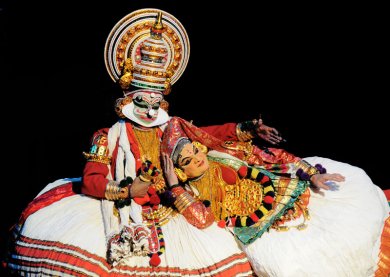 Sadanam Balakrishnan & Sadanam Sreenathan Senior Kathakali guru and exponent Sadanam Balakrishnan selected from Karthaveeryarjuna Vijayam composed by Puttiyikkal Thaman (1754-1824), the scene known as Kamaladalam. In this scene, shringara rasa is interconnected with sensuousness. Kathakali as a dance theatre form offers great scope for depiction of erotic and sensuous. Ravana character is of Kathi type and is rajasika in temperament. The scene opened with 'curtain look' of Ravana and then Mandodari. The story unfolds as follows: We see Mandodari sleeping with her head in lap of Ravana. But she wakes up and starts crying. Ravana asks her why when they had a happy time together, but she does not reply. In technical terms it is known as mana vipralambham. Even in the time of union, with suspicion and jealousy, viyoga, the separation is created. When Mandodari does not reply, Ravana tells her that whatever the reason of her unhappiness, he is her husband and she must confide in him. Ravana finally falls at her feet to please her, when Mandodari tells him about her dream in which Ravana makes love to apsaras, and consumed with jealousy, she suspects Ravana's love for her. Ravana addresses her as one with eyes like lotus - kamaladala lochani - and reassures her of his love. Mandodari then reconciles. Sadanam Balakrishnan's abhinaya, subtle expressions, netrabhinaya, mukhajabhinaya, were spellbinding. As a romantic great lover he delineated expressions becoming Ravana's character in unforgettable manner. As his consort, the young Kathakali actor Sadanam Sreenathan, impersonating female character Mandodari, succeeded in portrayal of a sulking woman, accusing lover of infidelity, even when it was just a dream. Kamaladalam is not often performed. I had seen it in 1958 when staged by the legendary Kunju Kurup asan at Jai Hind College hall in Mumbai. Kathakali aficionados say that none has excelled in its presentation. Watching Sadanam Balakrishnan I was amazed at his developing the role of Ravana. The impact was very strong and one at once realized that to achieve such artistry even a lifetime is not enough. Sadanam has earned reputation over long years of sadhana. There were subtitles in English projected on both sides of auditorium which helped the uninitiated audience to have entry point into complex story and abhinaya. The characters in Kathakali are larger than life. They demand of the spectators and audiences to have enough knowledge of abhinaya in Kathakali. The team of musicians on chenda, maddalam, the artist playing cymbals and the singer provided excellent support. One would congratulate NCPA to have faith in what lovers of Kathakali are known as Kathakalibhrantans. And Mumbai audiences proved that there are enough 'Kathakali mad' persons to enjoy the performance. The subtitles also helped a lot to follow the action. Odissi: Adyanta 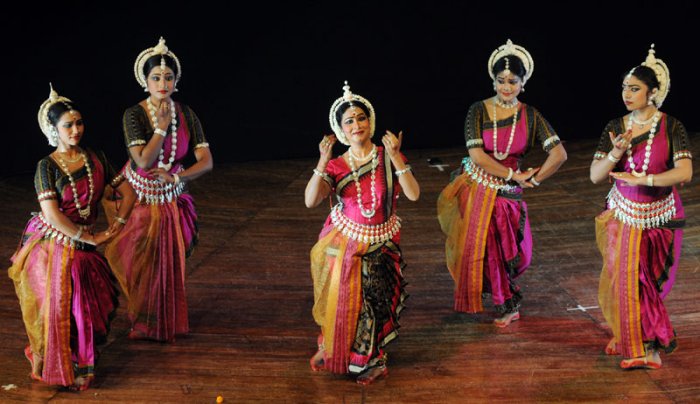 Sujata Mohapatra and group On April 22, daughter-in-law and disciple of Guru Kelucharan Mohapatra, Sujata Mohapatra presented Odissi as group dance titled Adyanta - Adi, beginning and Anta, the end. This was for the first time that she was bringing her group choreographic work in Odissi. She has been training several dancers for more than ten years at Srjan institution in Bhubaneswar where she is the Principal. Now it seems that a number of female and male dancers have received sound training under her and Sujata is now ready to embark upon group choreography. The troupe consisted of male dancers Soumya Bose, Trilochan Sahoo and Dushmant Sahoo. Female dancers were Ankita Sengupta, Sradhanjali Pusty, Prasanjit Jena, and Debasree Adhikari. Credit for the musicians: Mardala and manjira - Guru Kelucharan Mohapatra and Ratikant Mohapatra, violin - Ramesh Chandra Das and Agnimitra Behera, flute - Srinibas Satapathy, vocal - Bijay Kumar Jena and Rupak Kumar Parida, lights - Jayadev Das, script - Nityananda Mishra and voice over - Ravi Mani. The teamwork stood out for the excellent spirit which permeated the production. In her choreographic note Sujata mentions: 'I continue to use Guruji's rigorous training as guidance for my choreography. Adyanta reveals how closely dance and life and the divine are connected by delving into a dancer's life. The performance works on two levels - first at the level of the maturity of the dancer, and second in the way in which these different stages are lived out in all other spaces of life.' Adyanta is thus for her a metaphor for life. In Mangalacharan, 'Jagannatha swami' prayer is treated as birth and 'there begins the dance of life'. In next piece from Gita Govinda, "Srita kamlakucha" prayer, following Kelubabu's choreography Sujata explores through male and female dancers, episodes of Krishna subjugating serpent Kaliya, male dancers in a formation for Garudasana, image of Vishnu riding Garuda, for Ramavatara, the brief sequence of Sita garlanding Rama, then killing Dashakantha, ten headed Ravana, the fight between Ravana and Rama, imaginatively forming group of five dancers for Ravana, two male dancers as Rama and Lakshmana shooting arrows; it created interesting and engaging visuals. For young boyhood, the Batu nritya, with the old world charm recitation of the ukutas tak dha dha and dancers playing on veena, flute, manjira, drum, the sculptures as it were come to life. Three male dancers, sitting on floor, extend one leg and move in a circle, reminding one of earlier choreography. Sujata has created striking group visuals. Hamsadhwani Pallavi substituted for blossoming youth with melodious singing of ta jham ta jham tari jham ta derena and potala hasta, chibuakamandana postures, forming circles and dancing joyously, recitation of solfa, swaras. Sometimes male dancers and female dancers performed as it were in jugalbandi, and then Sabhinaya pallavi in raga Bilhari "Aaj mu dekhili Ghanashayamaku" - I saw dark lord, how he stole my heart - all in quick succession, were a sheer delight. "Sakhi he Keshi mathanmudaram" ashtapadi saw Sujata as Radha confiding to sakhi her first love encounter with Krishna. One has seen it in solo rendition as Radha going to meet Krishna, abhisara (lighting used imaginatively turning night into sudden darkness), Radha overcoming obstacles and then meeting Krishna, who with saying sweet nothings embraces Radha, pulls her garments - the entire sequence with Soumya Das as Krishna and Sujata as Radha, with suggestive lighting, in union, was handled delicately. Krishna disappears. Radha's telling sakhi of her ecstasy, overcome by utter delight and lajja, the enactment with three characters; the choreography captured the depiction of shringara sensitively and artistically. The metaphor for life completed with Moksha, end. Moksha had traditional ending with group performing together and ending with "Narayani namostute" prayer in a serene mood, permeating with shanta rasa. It brought down the house. The standing ovation by the audience spoke volumes for Sujata's intense performance and seamless choreography. One did not realize how one hour passed so quickly and the performance was over! Kathak: Widening Circles 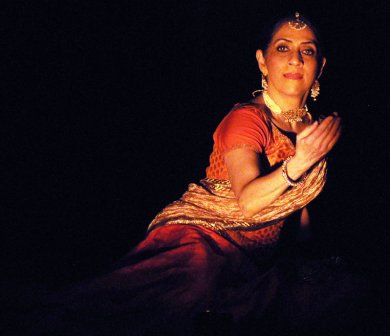 Aditi Mangaldas The grand finale came with Aditi Mangaldas's solo in Kathak titled Widening Circles. In her choreographer's note Aditi mentions that the work is based upon interdependent co-arising. This is, because that is. From arising of this comes the arising of that. As a seasoned dancer par excellence, Aditi has used the metaphor of the blossoming of lotus that connects to the ever widening circles of life. Through this imagery, she says that she has tried to explore the concept that everything is connected in this universe. From tiny atoms to vast galaxies, from simplest to the most complex, from the mighty to the minute… everything is linked and is connected... and within these circles of life is the beautiful flowering of Lotus, stating "Yes, I am." Aditi presented it in three parts - The Sun, the Earth and the Moon - the four musicians seated in one corner of the vast stage. She entered it with chanting of Surya stotra, Om Suryaya namaha, prasida Bhaskara and through vigorous movements, covering the stage with her amazing way of taking pirouettes, she captured the attention of audience. Sitting in front of small mike on stage she spoke, as Kathak form offers scope for dancers to recite not only padhanta, mnemonic syllables, but also recitation of poem, concept, shloka. Aditi's statement of connections mighty to the delicate and the minute was danced with forceful yet graceful Kathak, the use of silence very artistically dovetailed and imaginative lighting focusing on her when she spoke about widening circles, were extremely impressive. Appearing delicate and petite Aditi is a powerhouse of energy. The brilliant execution of dha taka thunga to the accompaniment of tabla and pakhavaj, the aalap by vocalist and the tuneful sarangi built up the mood. The percussion interlude followed giving ample scope to Ashish Gangani on pakhavaj and Mohit Gangani on tabla, filling the vast Tata theatre with complex talas and breathtaking execution, displaying their virtuosity and command. With change of costume in section on Earth, the poetic statement, 'Ah! Just as the bud opens at the crack of dawn, the stars wink and withdraw,' Aditi created a world of living beings, the fish, the birds, the deer, the ferocious tiger and the Kathak idiom lent itself to all these images. The contrasts with dance and silence, sitting on floor and reading French poet Rainer Maria Rilke's poem 'I live my life in widening circles….' echoing her innermost thoughts and with exquisite lighting, Aditi revealed her deep thinking which left indelible impression. In third section on Moon, the pangs of separation from the beloved are indicated by full blown lotus turning into bud as the moon rises. Connecting the blossoming of lotus with rise of sun and its once again turning into bud with rising of the moon, Aditi enacted abhinaya to Meerabai's song about "Birahan baithi rang bhavan me" in her chamber, shedding tears. The state of restlessness, difficulty experienced in absence of beloved, counting stars, awaiting him, the poignant mood was underlined succinctly. The image of a nayika with lamps roaming in palace, separated from the nayak had excellent visual by dimming the lights, creating darkness and only flickering lights of the lamp were seen. Concluding the dance, sitting in front of the stage lifting a book saying that she will widen circles, Aditi opened the book which opened like an accordion with dazzling light. Then slowly all lights were dimmed. The magic persisted and the audience burst into rounds of applause giving Aditi and her musicians a standing ovation. Aditi has been scaling great artistic heights pushing the boundaries of Kathak enriching it with poetry, movement, music, costume, lighting and coalescing various elements in a refreshing manner. Tata Theatre provided an aesthetic setting where like gems the artists shone forth, giving audiences an elevating experience. Outreach Programs, lec-dems and workshops Photos courtesy: Narendra Dangiya and NCPA The Mudra Dance Festival has many dimensions. A regular Outreach Programme for various schools is conducted for past several years. More than 50 schools have been covered where the students are introduced to the classical dance forms by leading local dancers. 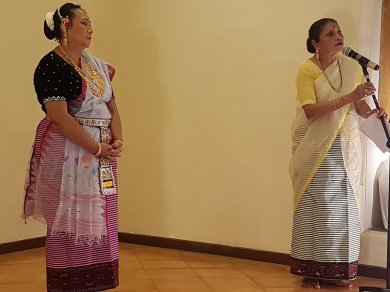 Latasana Devi & Darshana Jhaveri 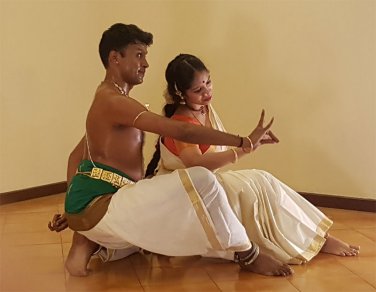 Satchidanandan & Jayalakshmi On 6th April at Somaiya Learning Centre, Fort, three dance forms were introduced with specific reference to Tandava and Lasya aspects. Darshana Jhaveri introduced the concepts explaining the meaning of these two important aspects of dance that are clearly seen in classical Manipuri dance. The gentle footwork and movements, graceful and lyrical as seen in dance of Radha, the vigorous, forceful dance, raising the leg above knee as seen in dance of Krishna were demonstrated by Latasana Devi and Darshana Jhaveri. In Odissi, Swapnokalpa Dasgupta and in Bharatanatyam, the husband and wife duo Satchidanandan and his wife Jayalakshmi demonstrated these two aspects. Painter Subodh Poddar drew sketches on the spot. On 11th April, I was invited to speak on Tandava and Lasya at a special presentation at J J Dharamshala, an orphanage run by Tata Charities for senior citizens above 60 and also those who are orphans without any means of support. This is the most humane and praiseworthy programme. There were more than 50 senior citizens, men and women from different communities who attended the programme. I spoke in simple language about dance of Lord Shiva who performed Tandava. How during a dance competition between him and Parvati, he raised his leg in Urdhva Tandava, and out of modesty Parvati did not raise her leg and Shiva won the competition. As a dancer he is called Nataraja and his Tandava dance became well known. Legend has it that Usha, daughter of Banasura who dreamt of Aniruddha, grandson of Lord Krishna, fell in love with him. She married him and came to Dwaraka and taught Lasya dance to the Gopis of Dwaraka. Usha was taught Lasya, delicate dance by Parvati. Thus Lasya dance became popular among the gopis. After this simple introduction Swapnokalpa Dasgupta in Odissi performed from Rabindranath Tagore's Chitrangada, the role of Princess Chitrangada, who was trained in archery and was brought up as a Prince, expert in warfare. Once while going for hunting, Chitrangada saw Arjuna doing penance and was drawn to him. She realized that Arjuna would not accept her as she did not look like a woman. She begged of Kamadeva to give her beauty as a woman, so Arjuna would accept her. They get married and have a son named Babruvahana. Chitrangada on reflection wants Arjuna to accept her as the woman she is, equal as a partner in whatever he does. She regains her former looks, and tells Arjuna to accept her as she is. Swapnokalpa performed the role in Tandava style when hunting and drawing arrows, and after her transformation into a beautiful woman danced gracefully in Lasya. Both the aspects were performed distinctly. As a mother looking after child Babruvahana she displayed gentle emotions. The melodious Rabindrik music enhanced both the aspects. Swapnokalpa is a disciple of Guru Kelucharan Mohapatra, and later on she studied under his disciple Paushali Mukherjee. A graceful Odissi exponent, I could see Swapnokalpa has received sound training under the great maestro and his disciple. Though petite, she engages attention with her graceful movements and appropriate expressions becoming the character. She is Head of the Dance Programming of NCPA and has brought fresh approach to its dance programming. Her initiative for Outreach Programme has been much appreciated. NCPA does not publicize it and carries on working silently. I was glad that I could take part in this program. 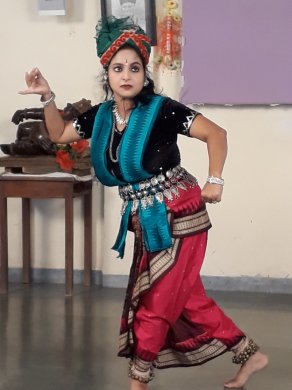 Swapnokalpa Dasgupta 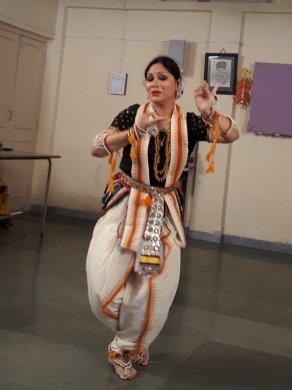 Purbita Mukherjee Purbita Mukherjee, a disciple of Guru Bipin Singh and Darshana Jhaveri, is daughter of Promita Mallik, the renowned singer of Rabindra Sangeet. Studying Manipuri from childhood when she was in Kolkata, she performs regularly along with Darshana Jhaveri. Darshana explained the distinction between Tandava and Lasya, how both are performed in Manipuri and Purbita performed it with her graceful movements. The tala aspect was also explained by Darshana. From Silchar, Brojen Kumar Sinha performed drum dance taking aerial rounds which were much appreciated by the older members of the audience. Mohiniattam was performed by Sujatha Nair who told the story of how Lord Vishnu had taken form of enchantress Mohini when the asuras and suras were engaged in churning ocean to get nectar, and Lord Vishnu had as beautiful enchantress managed to distribute it to the Devas. Sujatha presented a number from Mohiniattam in a graceful lasya mode. Then she performed Shankaracharya's Ardhanarishwara stotra and showed how on one side is Lord Shiva whose movements are full of vigour and on other side of body is Parvati whose movements are graceful. Sujatha has studied Mohiniattam from her mother Jayashree Nair. The audience was extremely pleased and met the dancers to compliment them. They had no opportunity to see such dance forms or meet artists. The lady in charge of Dharamshala thanked Swapnokalpa and NCPA and all artists. It was one of the most moving experiences. One more Outreach Program I attended was on 19th April at Municipal School, Colaba. When I arrived there I saw disciplined rows of school children in two separate rows, one for girls and other for boys. They were led by their teachers to 2nd floor into a large hall with a stage for performance. They all settled down quietly. Swapnokalpa and three other dancers welcomed them. Swapnokalpa moved among the school children and spoke in Hindi about the four dance forms. She established rapport at once with her gentle talk asking them how many of the girls and boys were learning classical dance forms. Some twenty girls raised their arms and said they were learning Kathak. Then she explained tribhanga element of Odissi showing them the pose. The dancers had chosen to dance on theme of seasons. Swapnokalpa performed few stanzas from Gita Govinda describing Vasant season with ashtapadi Lalitalavangalata and performed it in a leisurely mode. Purbita Mukherjee dressed in Manipuri costume, selected a song from Bhanusingher Padabali describing how Radha went to meet Krishna in a dark night. Students knew about poet Tagore. She explained how Tagore wrote this poem under a different name Bhanusingh, meaning Sun, his real name Ravi. Swapnokalpa explained how looking at costumes students can recognize the dance form - Odissi with sliver Bengpatia - waistband, Manipuri with colourful costumes, Kathak with flaring skirt and many ghunghroos, Mohiniattam with typical bun hairstyle and beige colour costume with gold borders. These were explained showing various ornaments and costume the dancers had worn. 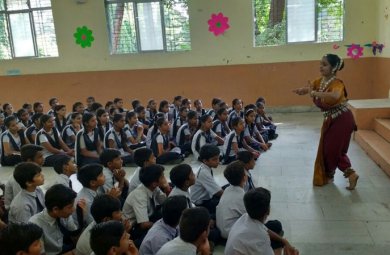
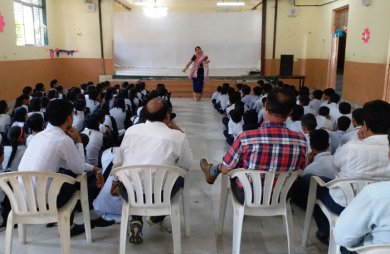
Municipal School,
Colaba
Sharmistha Chattopadhyay presented Mohiniattam. Though she is trained in Odissi, she also has studied few items of Mohiniattam repertoire which students said that they had not seen earlier. Pallavi Raisurana, a disciple of Kumudini Lakhia, presented rainy season in Kathak. She used tatkar to suggest drops of rains falling, the lightning with arm movements across her chest, and then with footwork in fast tempo, the rain. As usual students appreciated her chakkars with loud clapping. The Principal thanked NCPA for its initiative. The exposure that students receive through such informal presentations goes a long way in introducing the classical arts at grass root level. Like the wonderful work SPIC MACAY does, NCPA works in its own way and both the institutions' work is much appreciated. However, when I asked Swapnokalpa about collaboration with SPIC MACAY she said that working independently NCPA is able to manage things as per their own schedules. The very fact that, besides their extremely busy and highly professional engagements, NCPA has found a way to reach out to different communities of students, underprivileged class and orphanage inmates is highly commendable. I had another engagement on 13th April and therefore I missed the opening major event of multi dance style presentations. It covered Bharatanatyam by Dr. Sanddhya Purechha and troupe, who explored connection between dance movements in Bharatanatyam linking with sculptures, literature and gatis, charis, karanas from texts of Natyashastra and Abhinayadarpana, and also linked with idols of gods and goddesses. Astad Deboo working with music by Baha'uddin Dagar performed his contemporary dance. Uma Dogra and her troupe in Kathak established connection with rhythm of universe, bonds with environment, eternal intertwining of life and death. Sethu conceptualized by Lata Surendra was an ambitious presentation, a metaphor for the bridge that connects each one of us to the flux of existence, as we all are part of a dynamic, mutually interconnected whole in which the visible and invisible world go hand in hand. The pulsating synergies of inter-connectedness were expressed through a team of dancers in different styles - Lata Surendra in Bharatanatyam. Latasana Devi in Manipuri, Prateesha Suresh in Sattriya, Dr. Tina Tambe in Kathak, Deep Mehta and dancers of his company in contemporary and Sunil Sunkara and Mayur Vaidya team in Kathak. 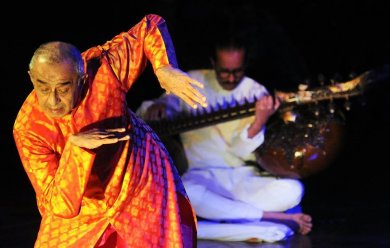 Astad Deboo & Baha'uddin Dagar 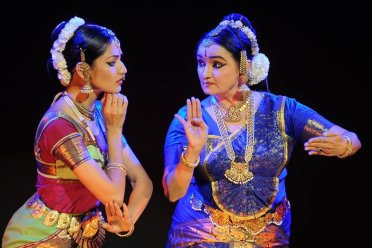 Sanddhya Pureccha & group 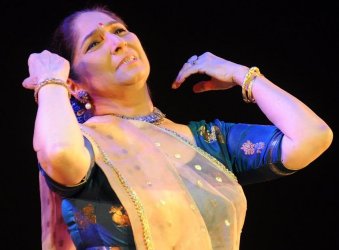 Uma Dogra 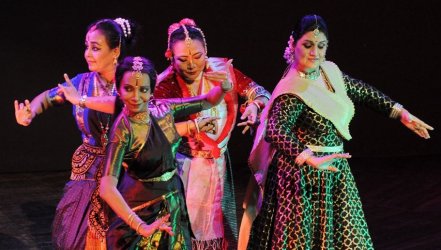 Prateesha Suresh, Lata Surendra, Latasana Devi, Tine Tambe Swapnokalpa had planned Mudra Dance Festival inviting these artists to ideate, discuss, exchange views to plan well in advance. I could see the hard work all of them put into this unique festival. The other programs consisted of workshops, lectures by artists performing on last two days 21 and 22 April. In order to avoid overlap of other major dance festivals being presented concurrently, later dates were fixed and in the mornings and convenient time before evening performances, lecture demonstration on interdependence between music and dance were organized. On 18th April at Little Theatre, Harikrishna, son of senior Bharatanatyam guru Kalyanasundaram Pillai, gave an illuminating lecture on nattuvangam, with demonstration by his disciple Krishna Pranita. Harikrishna started with explanation of punctuation and accents in nattuvangam and demonstrated it through various compositions. Starting with a khanda Alarippu in raga Valachi, his playing on mridangam adapted with the different instruments he used in the composition, flute, veena and violin, the division of the khandam - 5 beats, in various combinations was highlighted. The interdependence of the music and dance was illustrated giving a few examples. The various divisions of a tala were presented in a few compositions. A jathi from a jathiswaram in raga Charukesi set to misra chapu tala, nattuvangam for jathi recitation was highlighted along with additive choreography in the dance. Nattuvangam for swara patterns were highlighted in another piece, a jathiswaram in Brindavana Saranga set to roopaka tala, a trikala jathi to draw attention to very complex rhythmic patterns, with varied adavus interwoven in an exquisite manner. Nattuvangam for bhava was presented in the varnam in raga Keeravani, adi tala. Episodes depicting the story of Yagnaraman were selected. The voice in neraval form for Sita and Mareecha, with the use of flute, and accents by nattuvangam, the use of graha bheda in Keeravani to go to Revathi at the moment when Ravana disguises himself as sage, a brilliant raga graha bheda was employed supported by nattuvangam. A few more illustrations of nattuvangam for various moods and bhavas were presented through two compositions: One a javali Saramaina in raga Behag, a short section of the dance which was set to the prelude with a veena without the nattuvangam and then with the rhythm just to highlight the different moods. The dancer Krishna Pranita handled both nritta and nritya competently. A bhajan, a composition of Narsinh Mehta in Gujarati, Mehulo gaje, ne Madhav nache (the clouds give sound and Madhav dances) was interestingly set up with silence and enhancement of his bhakti coming through, ending with the vision of the divine rasa of Krishna and salutations to the Lord Krishna by the poet. A Ragamalika Tillana in Todi, Khamas, Valachi, set to misra chapu tala with the vintage mei adavu pattern and nattuvangam to illustrate the patterns was demonstrated to make the point. The session ended with a section from a composition of Saint Thirumular, Sivamayam, with description of Shiva Nataraja. It had all elements - a swaram, sahityam, jathi, complete silence when the dancer showed the sharanagati and a vivid description of Shiva's movement - being omnipresent in the five elements, the devas, raksasas, kinnaras, humans, birds, animals, mountains and rivers, the cycle of birth and death, the constellations, cosmos and space; the rhythm in everything is Shiva and Lord Shiva is everywhere, came through this illustration. The crisp patterns, choreography and proportion of short segments from various compositions brought the inter dependence of dance and nattuvangam. Especially this drew attention to Thanjavur bani of Kuppiah Pillai and of Guru Kalyanasundaram, in which nattuvangam is the soul of the dance. Thus one saw that the music, choreography, lyrics and all departments are interconnected. 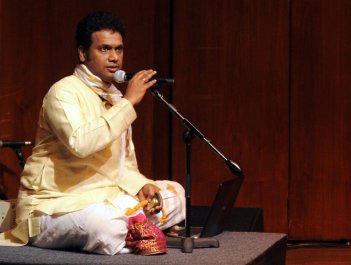 Harikrishna 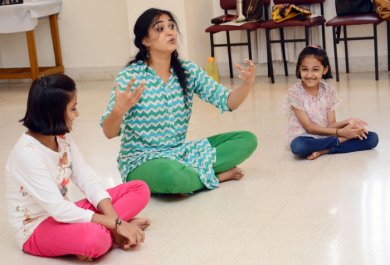 Sanjukta Wagh On the 15th morning, Kathak exponent, choreographer and composer Sanjukta Wagh took up in the workshop the exploration of text and its embodiment covering various ways of approaching the word and its relevance in different modes of performance, movement improvisation and studio based task. Sanjukta focused on the collective inquiry into the phonetic and rhythmic possibilities of words in performance. Those who have seen her work Jheeni had an advantage of how she explores various layers of text and co-relates with movement in a performance. In the afternoon Subodh Poddar whose paintings are inspired by dance talked about his work and also encouraged participants to create sketches. During Konark Dance Festival, similar explorations are done by a painter watching the dance performances and simultaneously creating paintings. This aspect of inter-connectedness between plastic art and performing art, painting and dance was another noteworthy feature of Mudra Dance Festival. 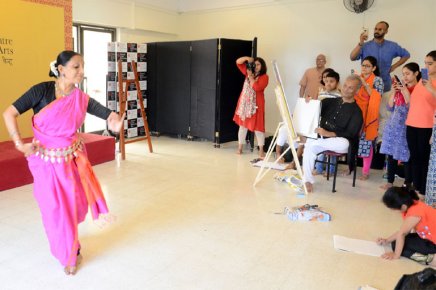 Subodh Poddar 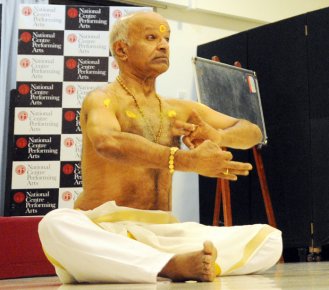 Sadanam Balakrishnan The lecture and demonstration on 20th April in the evening at West Room of NCPA by Sadanam Balakrishnan was most engrossing. It was aimed at getting clear understanding of terms Natya, Nritya and Nritta. Sadanam chose to speak on Natya, basing upon his study of Kathakali. The quotations from Abhinayadarapana and other Natyashastra texts were analyzed. He covered nritta saying nrittam talalayashryam, pure dance as dependent upon tala and laya and demonstrated with stamping of the feet dhi dhi thai, and how to measure some actions in tala. Speaking on Nritya, expressional dance, he explained what is meant by Padarthabhinaya - word to word expression - and Vakyrthabhinaya - overall meaning of the sentence. What was most interesting was his observation on bhava, sentiment. It is generally understood that bhava is projected by actor and rasa is enjoyed by spectator. But he said that even actor has to enjoy rasa and not only express bhava. He said that nritya produces and is not dependent upon only bhava. The intricate aspect of representational dance as Natya with four types of abhinaya included vak, and mukharaga. These mukharagas of four types included svabhavika, natural, prasanna, pleasant, rakta, red and shyama, dark; without mukharaga the abhinaya is like a vegetable without salt. The way he concentrated and developed mukharaga was an exercise that one rarely sees. He demonstrated the importance of breathing, to remain totally relaxed, then energy gathering upwards from muladhara, below, and creating mukharaga. The importance of elaborate costumes, use of different makeup as per the character and his or her temperament and sattvika abhinaya were explained clearly. In Kathakali emphasis is on Natyadharmi mode of abhinaya than on Lokadharmi mode, because rasasvadana, relish of aesthetic joy is found in Natyadharami, stylized than ordinary abhinaya. The well known statement of vigalita vedyantaram, losing the sense and becoming one with what is presented leading to brahmananda sahodara rasa is the purpose of dance. Sadanam demonstrated eye practices as done in Kathakali. Putting pure ghee butter in the eyes and how exercises are done in Kathakali was explained and participants attempted to follow his directions. How only with eyes abhinaya is done is a fascinating aspect of Kathakali. He mentioned how Kalamandalam Krishnan Nair used to perform it. He had practiced eye exercises to such an extent that his eyes were swollen. But that sadhana gave him extra dimension in his abhinaya. In Koodiyattam the presentation of agnishalabha, the moth flying to flame and jumping into it is shown which is astounding. It is said that eyes are the mirrors of soul. With his colleague who played female role, Sadanam presented an excerpt from Narakasuravadham. He played role of Arjuna's son Jayant. Narakasura's sister gets enamoured of Jayant's beauty and begs of him to marry her and rushes to embrace him several times revealing her form of demoness. Jayant avoids her and finally cuts off her nose and as Nakratundi, whose nose is cut off, she runs wildly. To the accompaniment of chenda, maddalam and cymbals, the brief demonstration was highly dramatic. What Natya means in Kathakali was thus explained by Sadanam Balakrishnan in a captivating manner.
Next morning of 21st April in Sea View Room where there are mirrors, Aditi Mangaldas took the class for advanced Kathak practitioners. I was told that in earlier workshops Aditi had worked on druta and madhya laya for Dha Taka Thunga compositions. This time she worked on vilambita, slow tempo. Some twenty dancers had registered. Aditi explained why it was important to first have warm up exercises. The body has to warm up for difficult exercises. The spine, the thighs, the muscles all have to be tuned. She asked dancers to follow what she was doing executing dha taka thunga mnemonics, and how legs move, how arms move, how body takes turn, where the weight shifts, how shoulders have to be kept, and what to avoid when executing the bols. Such minute analysis and deconstruction of movements was a revelation for majority of dancers. When performing in fast tempo, the parts of the body, arms, head, and shoulders can get into wrong positions. This was illustrated by repeating the movements. The accompanists played the bols on tabla and pakhavaj and later on Aditi asked participants to practice minus the accompaniment. The entire exercise for two hours was fascinating. I have always enjoyed these workshops as they give an insight into the graceful movements of Kathak in different time measures and tempo. Aditi has maintained a slim figure daily doing necessary exercises to keep body fit. At fifty plus she is able to perform with such energy and speed, maintaining the formal beauty of Kathak. Having studied under Kumudini Lakhia and Birju Maharaj she has further honed her skills with observations. No wonder she stands out in her choreographic works. I look forward to attending her other workshops.
On 22nd April morning in West Room, Priyadarsini Govind gave a workshop in Bharatanatyam teaching 19 registered dancers, a Kavuthvam in praise of Shanmugam. She started dot on time at 11am and barring only two rest periods of five minutes each, taught them the movements giving instructions on how the body has to move with eyes, arms, hand gestures following in a clear way, avoiding jumbled movements. Each stanza was explained and also the bhavas to go with them. Son of Lord Shiva, how he was born, his six faces, his vehicle Mayur, his consort Valli, the devotees dancing the Kavadi, taking circular floor movements on knees, getting up quickly and following in a particular direction, the face wearing subtle expressions encompassing the mythological references and ending with poise and deep feeling of devotion. For two and half hours, I must say to the credit of the practitioners, they repeated and followed Priyadarsini's instructions, though exhausted, but achieved the expected standard of learning the item. They were all dancers with advanced training. It was heartening to see them absorbing what Priyadarsini offered. She explained gently to whoever could not follow, how best to perform in a correct way. Later on I asked Priyadarsini how she developed such patience in transmitting the technique. She said she was lucky to have learnt from her gurus and in particular Kalanidhi Narayanan, who took pains to teach. That sound training from young age has stood her in good stead when she is teaching. She appreciated the young dancers who grasped the composition so well. They were given the recording to practice and seemed happy to have such intense master class. Mudra Dance Festival with its diverse aspects was a rewarding experience.  Dr. Sunil Kothari is a dance historian, scholar, author and critic, Padma Shri awardee and fellow, Sangeet Natak Akademi. Dance Critics' Association, New York, has honoured him with Lifetime Achievement award. Post your comments Please provide your name and email id when you use the Anonymous profile in the blog to post a comment. All appropriate comments posted with name & email id in the blog will also be featured in the site. |